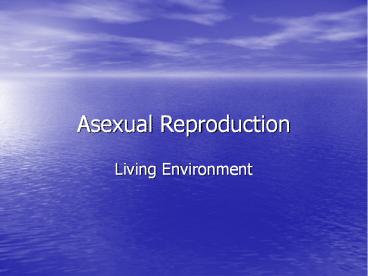Asexual Reproduction - PowerPoint PPT Presentation
1 / 26
Title:
Asexual Reproduction
Description:
Asexual Reproduction Living Environment – PowerPoint PPT presentation
Number of Views:104
Avg rating:3.0/5.0
Title: Asexual Reproduction
1
Asexual Reproduction
- Living Environment
2
Cut it half
- Binary Fission simplest form of asexual
reproduction. Parent organism divides into two - approximately equal parts. Each daughter cell
becomes a new individual.
3
Binary Fission
4
Bacteria
- Bacteria
- No organized nucleus.
- Genetic material in the form a single circular
chromosome. - Before division starts chromosome is replicated
then each daughter cell gets one copy of the
chromosome. - Can occur every 20-min.
5
Protozoan
- Protozoa Mitosis occurs. Cytoplasm
- pinches in and divides the organism in half.
Each half has a copy of the genetic material.
Diagram.
6
They Where best buds
- Budding Parent organism divides into two
unequal parts. - The new organism is created as a smaller out
growth or bud on the outside of the parent. - Buds will brake off and live independently or
remain attached and form a colony.
7
Budding
8
- Yeast Once the yeast cell reaches a certain
size it undergoes mitosis. - Once the genetic material is replicated budding
begins. - Hydra Cells on the outside of the parent hydra
begin to undergo mitotic division creating a
small group of cells. Those cells continue to
divide until in a completely new hydra is formed.
Can also reproduce sexually.
9
- Yeast cell cycle including budding
- http//brodylab.eng.uci.edu/cgi-bin/jpbrody/animat
ion/files/13-977277560.html
10
Can I have some spore?
- Spore Formation spores small specialized
cells that contain a nucleus and cytoplasm
surrounded by a thick outside wall which protects
the spore. Under the right conditions the spore
can rise to a new organism. Found in bacteria,
molds, yeast, mushrooms, mosses, ferns and some
protozoans.
11
Spore formation
12
Dont try this at home
- Regeneration The ability to re-grow lost or
damaged body parts. Hydra, planaria, starfish,
and earthworm More complex animals less able to
re-grow parts. Crab can re-grow a claw. Some
reptiles can re-grow a tail. Most mammals can
repair damaged tissue but can not re-grow missing
parts.
13
Regeneration
14
- Vegetative Reproduction
15
- Bulb Short underground stem surrounded by thick
leaves. Contain stored food. As the plant grows
it produces new bulbs which will grow into new
plants. Tulips, onions, and lilies.
16
- Corms Similar to bulbs but do not contain
leaves, just underground stems. Water chestnuts.
17
- Tuber enlarged part of an underground stem that
contains stored food. Potatoes are tubers.
Eyes tiny buds that can form a new potato
plant. How you plant potatoes. Great potato
famine.
18
- Runner or stolen horizontal stem above the
ground with buds. If a bud touches the ground it
will form roots and stems and start a new plant.
Strawberries.
19
- Rhizome horizontal stem that grows underground.
Thick and contains stored food. Upper portion
form nodes which will form buds which will form
new plants. Lower portion forms roots. Ferns,
cattails, and water lilies.
20
Artificial Vegetative Reproduction
21
Watch out for those old ladies.
- Cutting use a portion of a developed plant to
make a new plant. Roses, ivy, and grapevines are
reproduced in this way.
22
- Layering a stem is bent so that it is covered
with soil. Once the branch forms roots it is
disconnected from the original plant.
Raspberries and roses.
23
- Grafting Bud or stem of one plant is
permanently attached to the stem or trunk of a
very similar plant. The cambium layers grow
together and form a single plant. Apple trees.
24
Thats a strange cacti
25
Why Bother??
- Advantages to artificial vegetative propagation
- 1. Plants that grow from seed are not always
exactly the same as their parents. - 2. Takes less time to artificially propagate.
- 3. Can create seedless fruits.
- 4. Grafting can be used to generate higher
levels of fruit and nut production.
26
Websites
- Yeast cell cycle including budding
- http//brodylab.eng.uci.edu/cgi-bin/jpbrody/animat
ion/files/13-977277560.html - Mitosis animation
- http//brodylab.eng.uci.edu/cgi-bin/jpbrody/animat
ion/files/6-973887139.html































